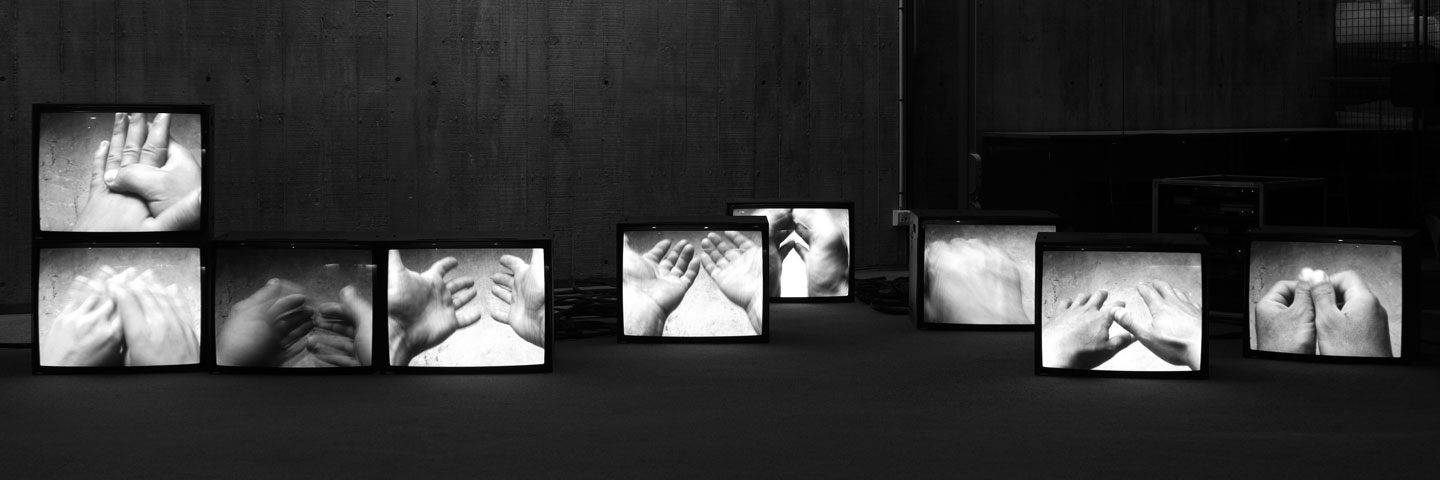
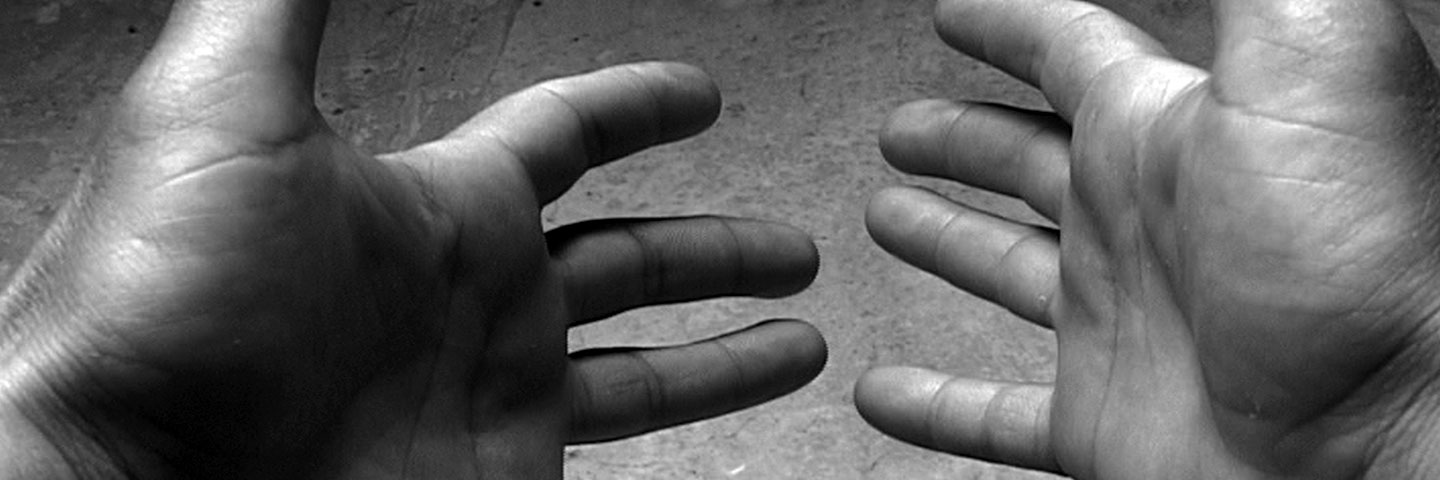
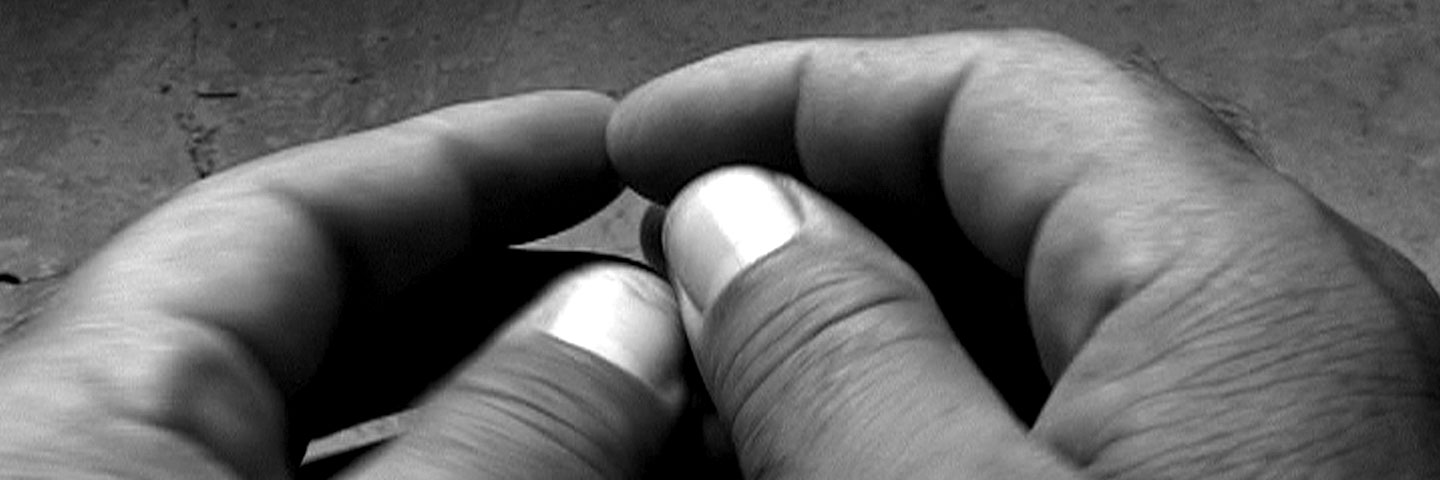
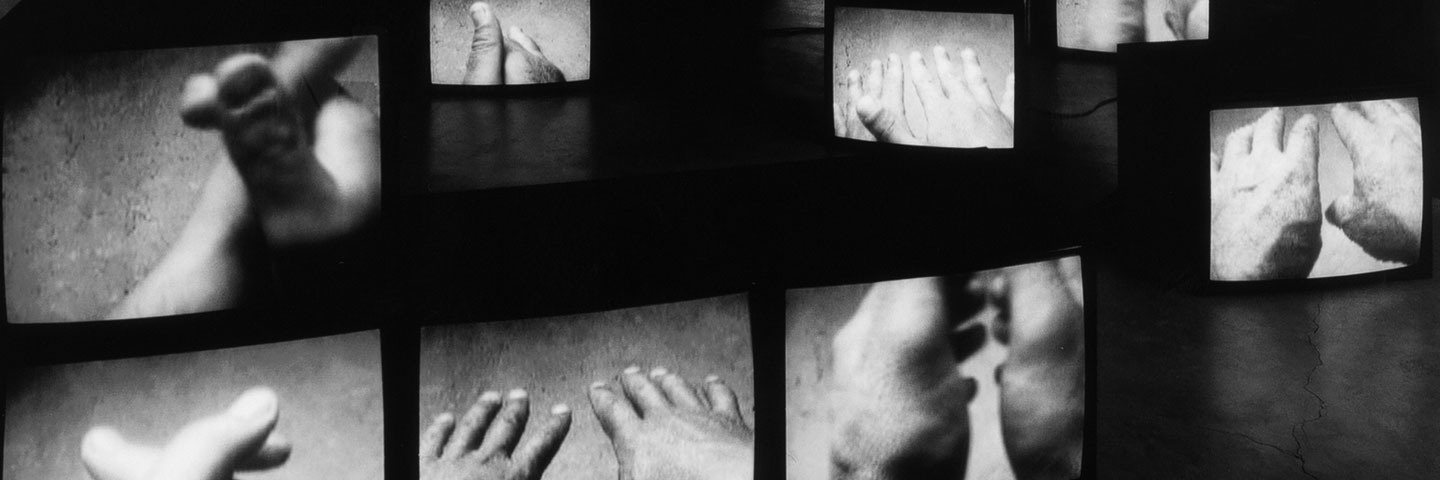
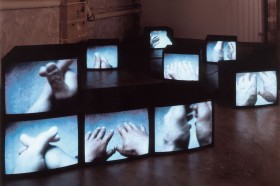
Ces mains, à qui sont-elles ? Rien ne permet à l’écran de les reconnaître. On les observe : des mains d’hommes, des mains d’hommes qui ont vécu, et surtout travaillé ; des mains ballantes, qui se rejoignent, s’étendent ou se serrent, et claquent – une fois. Il y a neuf écrans à terre, autant de fois deux mains qui claquent, autant d’hommes dont on ne voit que les mains. On les voit puis, ce n’est pas tout de suite, on les entend – mais qu’entend-t-on ? Plus qu’un son, une pulsation, le rythme de sons montés en séquences, une musique extrêmement simple, aussi vive, dépouillée que cette image de mains seules sur fond bleu sombre, uni.
Après, il raconte. Qu’il a voulu filmer les mains d’ouvriers en grève, ceux d’une usine, en France ; et puis c’était trop compliqué, cela n’a pu se faire. Il restait peu de temps, c’était juste avant le voyage en Arménie, avant l’exposition d’été. Il est parti. Et c’est là-bas que les choses ont eu lieu. Là-bas il y avait cet endroit, le sous-sol d’un cinéma, une sorte de bourse du travail, même pas clandestine, là-bas c’est comme ça, d’un autre âge, ces hommes qui attendent là qu’on les choisisse, des heures, des jours, qu’on leur donne une tâche. Pour un dollar ils vous suivent. C’était bizarre, dit-il, on s’est retrouvé dans l’appartement d’un ami ; ils étaient neuf hommes, auxquels il a demandé s’ils pouvaient taper dans leurs mains, une seule fois, s’il pouvait les filmer à cet instant-là. Ils ont dû dire oui. Ensuite il est rentré, a monté les images, samplé les sons, constitué cette bande sonore avec un ami musicien, ces trois boucles, comme on voit en boucle à l’écran les quelques secondes filmées de ces mains qui reposent et s’étreignent, qui battent – des mains qui ont tant travaillé, qui tirent de là leur identité, mais cette fois font autre chose.
Elles font voir et entendre autre chose. Et les voilà qui peuvent exister ailleurs, bien loin de cet endroit où ils étaient sans emploi, les voilà qui peuvent être regardés, grâce à leurs mains. Sans doute elles sont comme d’autres mains d’hommes qui travaillent, partout. On ne peut les toucher, on devine, on peut imaginer à les scruter à quel travail elles se livraient, rudes mais douces, fortes et assurées, capables – la main, meilleur outil. Ici elles ont ce claquement sec qui se mue en ligne sonore, dynamique accompagnement digne, à suivre. Elles répondent à la proposition qui leur a été faite d’un geste inédit, qu’ils n’auront jamais eu dans leur travail, qui ouvre un horizon. Frapper dans ses mains, n’est-ce pas agir et marquer la fin d’un état d’abandon, ne plus attendre, c’en est assez. Le son développé, c’est autre chose encore, presque l’esquisse d’une danse, fête, l'économie d’une célébration d’hommes qui, s’ils se taisent, bougent, sont là.
Qu’ont-ils pensé alors, que penseraient-ils de ce résultat : on n’en sait rien. Lui le saura peut-être, il leur montrera ce qu’il a fait de ce moment étrange où il est allé les chercher, où ils ont répondu. En tout cas ils l’ont fait, lui et eux, il a filmé leurs mains ; s’il ne fait pas d’eux autre chose il leur permet d’être autrement. L’image sobre, concentrée sur son objet, ne garde pas vraiment la mémoire de ce moment, ni des vies entières au travail, d’un quotidien si précaire, inconnu. Lui seul sait quels étaient leurs visages : nous manquent-ils, non, les mains en disent assez.
Telle est la bénédiction : nous y sommes – là où ces mains battent ; où le claquement des mains de ces hommes sans travail devient musique immobile, transporte ; où le désœuvrement se transforme en invite, partage.
— Anne Bertrand (extrait de la monographie Kristale Company, p.88. 2003)
Who do these hands belong to? On the screen there is no way of recognizing them. We look at them: hands of men, hands of men who have lived and above all worked; hands dangling, which are joined, stretch out or clasp, and clap – once. There are nine screens on the ground, as many times two hands which clap, as many men whose hands we cannot see. We see them, then, not right away, we hear them – but what do we hear? More than a sound, a beat, the rhythm of sounds edited in sequences, extremely simple music, as live and spare as this image of hands alone on a dark blue even ground.
Then he talks. He tells how he wanted to film the hands of workers on strike, at a factory in France; and then it was too complicated, and it couldn’t be done. There was not much time left, it was just before the trip to Armenia, before the summer exhibition. He left. And it was there that things happened. Over there there was this place, the basement of a cinema, a sort of labour exchange, not even illegal, over there that is how things are, from another age, those men waiting to be chosen , hours, days, to be given a job. For a dollar they follow you. It was weird, he said, we ended up in a friend’s appartment; there were nine men, and he asked if they could tap in their hands, just once, if he could film them at a particular moment. They must have said yes. Then he returned, edited the images, sampled the sounds, made this soundtrack with a musician friend, these three loops, just as you see looped on screen the few filmed seconds of those hands resting and clasped, beating hands – which have done so much work, which derive their identity from that, but this time are doing something else.
They made us see and hear something else. And they can exist elsewhere, well away from that place where they were jobless, they can be looked at, thanks to their hands. They are probably like other hands of men who work, every where. We cannot touch them, we guess, we can imagine by examining them what work they do, rough but gentle, strong and confident, capable – the hand, the best tool. Here they have this sharp clapping which turns into a sound line, worthy dynamic accompaniment, to be followed. They respond to the proposeal made to them by a novel gesture, which they have never had in their work, which opens up a horizon. Clapping hands, is this not acting and marking the end of a state of abandon, not waiting any more, that is enough. The sound developped is something else again, almost the sketch of a dance, party, the economy of a celebration of men who may be quiet but move, and are there.
So what did they think, what might they think of this result: we don’t know. He may possibly know, he will show them what he did with that strange moment when he went looking for them, when they answered. In any event, they did it, he and they, he filmed their hands; if he does not do something else with them, he permits them to be otherwise. The sober image, focused on its object, does not really retain the memory of that moment, or whole lives at work, such a precarious, unknown daiy round. He alone knows what their faces were. Do we miss them, no the hands say enough. Such is the blessing: we are there – there where these hands beat; where the clapping of the hands of these men with no work become motionless music, transports; where being at a loose end is turned into inviting and sharing.Video Melik Ohanian
Assisted by David Kareyan
Soundtrack by Varou Jan
Resolution: 1280x720
All Rights Reserved © Melik Ohanian
Resolution: 1280x720
All Rights Reserved © Melik Ohanian